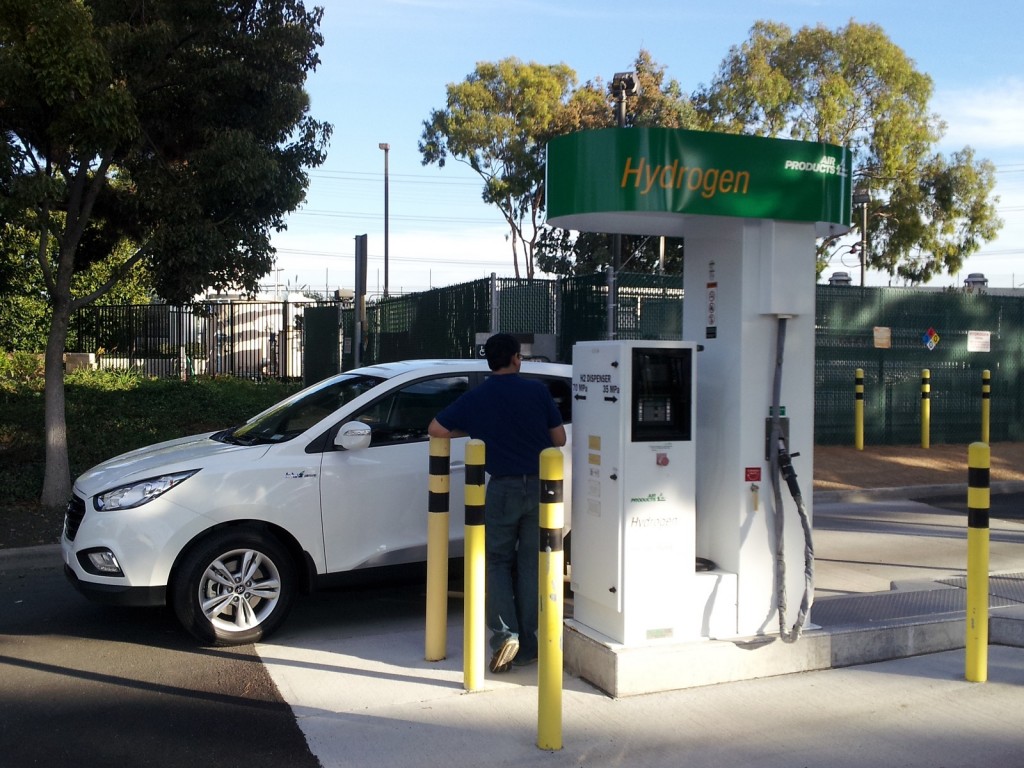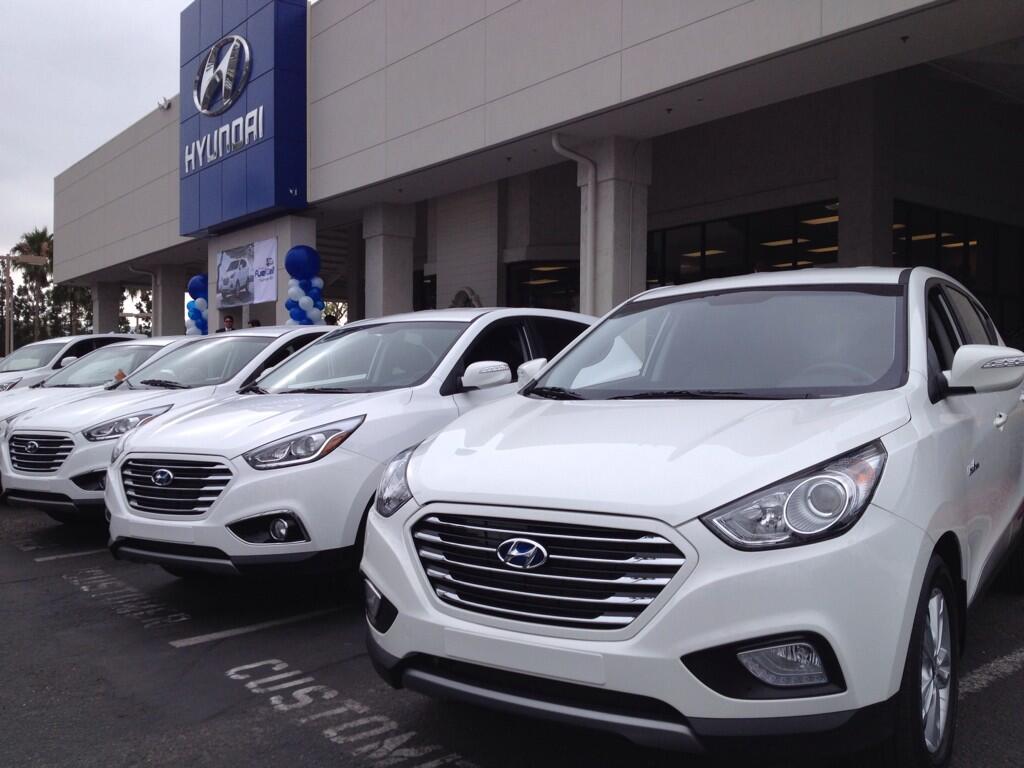This coming week will bring news of at least two new hydrogen fuel-cell vehicles from major global manufacturers.
They'll be offered only in small numbers for the next few years--far smaller than plug-in electric vehicle sales over the same period--but Toyota, Hyundai, and Honda fully intend to make fuel cells a viable zero-emission vehicle technology for the future.
Last month, we published our suggestions for 10 questions that carmakers will inevitably be asked as they launch hydrogen fuel-cell vehicles in the coming years.
DON'T MISS: 10 Questions On Hydrogen Fuel-Cell Cars To Ask Toyota, Honda & Hyundai
Toyota will give us more details about its production fuel-cell vehicle, now known just as the Hydrogen Fuel Cell Sedan, this week at the Los Angeles Auto Show.
Meanwhile, Honda is working on its own fuel-cell car, a successor to its FCX Clarity, and we may get more details on that car as well.

2009 Honda FCX Clarity
Finally, there will be several dozen Hyundai Tucson Fuel Cell crossover utility vehicles in use in Southern California by the end of next month, with more planned for next year.
Each of these three carmakers, along with the California Fuel Cell Partnership, submitted written answers to our 10 questions; this piece is the third in a series of articles summarizing and evaluating those responses.
ALSO SEE: Hydrogen Fuel-Cell Car Questions: Toyota, Honda & Hyundai Respond (Part 1)
MORE: Hydrogen Fuel-Cell Car Questions: Toyota, Honda & Hyundai Respond (Part 2)
These articles have now generated more than 1,250 individual comments in response to the various claims, studies, and assessments. Clearly there's interest in the topic among our readers.
Below, we've summarized the four answers--rather than reproducing them in their entirety--to highlight common themes and note differences among the four responses.
Today, this third article in our series covers two questions we grouped under the heading, "Energy Balance."

2015 Hyundai Tucson Fuel Cell at hydrogen fueling station, Fountain Valley, CA
QUESTION 1
The wells-to-wheels footprint of a hydrogen-fueled vehicle appears to be generally worse than that of an electric car *IF* the analysis uses the same grid source for both alternatives. (Many studies don't use the same source.) That appears to imply that among the broad range of zero-emission vehicles, hydrogen vehicles have a higher carbon footprint than electric cars. How do you overcome this?
Interestingly, this question produced shorter answers than we'd expected.
All responses to this question were framed by noting that both types of vehicles had vastly lower carbon footprints than conventional vehicles--which is entirely true.
But none of them directly denied that hydrogen vehicles can have a higher carbon footprint than do battery electric vehicles, if carbon footprint of the energy sources used to make the hydrogen is the same as that used to recharge electric cars.

2015 Hyundai Tucson Fuel Cell at hydrogen fueling station, Fountain Valley, CA
Toyota called the emissions profiles of the two vehicles types "very similar--within spitting distance, you might say" when the same primary energy source is used, offering natural gas as an example.
Honda said it's most appropriate to compare the anticipated future grid to the mix of multiple pathways expected to make up the production of hydrogen.
We would add that apparently the hydrogen produced for transport use will be quite different from industrial hydrogen in its energy footprint.
Underscoring that point, the California Fuel Cell Partnership noted that the state's mix of hydrogen used in fuel-cell cars will have a similar carbon footprint to the electricity from the grid used to recharge battery-powered vehicles in the state.
That's because the California Air Resources Board expects fully 46 percent of the hydrogen used for transportation to come from renewable sources by the end of 2015, when all hydrogen stations planned by that date are operating.
Hyundai added that California's hydrogen for vehicle use will have to be produced using at least one-third renewable energy, which will bring the per-mile emissions quite close to those of a battery-electric car.
The Korean maker also noted that using renewable energy to make and store hydrogen may offer a greater possibility to use renewable energy when it is available.
That helps utilities avoid having to manage potential mismatches between the times most renewable energy is available (e.g. solar during the day) and the times that most electric cars are recharged (e.g. overnight).

2015 Hyundai Tucson Fuel Cell at Hyundai headquarters, Fountain Valley, CA
The Partnership also noted that "most people buy a car based upon factors other than its carbon footprint, including reliability, comfort, styling, and mileage."
Absolutely true, although we might gently suggest that the question remains apropos if the goal is to minimize the carbon footprint of miles covered by a growing fleet of zero-emission vehicles projected for California by 2050.
Finally, Hyundai underscored the dangers of relying upon a single powertrain solution (meaning battery-electric vehicles) if anticipated breakthroughs in technology and cost reduction do not arrive as expected.
OUR TAKE: Hydrogen vehicles can be as low-carbon as battery-electric vehicles under some circumstances. And it appears that the few thousand that will appear on the roads of Southern California within two or three years may well hit that mark, as they will in some other locations--including Germany.
To make that the case, however, requires that the hydrogen fuel be produced using a far higher proportion of renewable energy than is used in the average grid mix anywhere in the U.S.
Photovoltaic solar power field at Volkswagen plant in Chattanooga, Tennessee
Imagine how the numbers might look if electric cars in California were all recharged on grid electricity that was 33 percent or 46 percent renewable. If that came to pass, hydrogen vehicles would consistently have a higher carbon footprint than their battery-electric competitors.
That said, there's some validity to the notion that two zero-emission vehicle technologies are probably a safer way to proceed than one--at least until global manufacturing capacity exists for millions of electric cars a year powered by batteries cheap enough that the cars can be bought at the same price as gasoline vehicles in the same segment.
In other words, our respondents seem to be saying, let's not let the perfect be the enemy of the good this early in the zero-emission vehicle game. Which we think is fair.
QUESTION 2
Much dispute currently exists over the carbon footprint of manufacturing batteries and electric motors for electric cars. Have you studied the lifecycle carbon emissions, including manufacturing, of the fuel-cell vehicle--and what were the results?
The California Fuel Cell Partnership succinctly provides the consensus statement here: "The short answer is that fuel-cell and battery-electric vehicles have a similar footprint."
![Toyota Fuel Cell Sedan at Aspen Ideas Festival [photo: Riccardo Savi] Toyota Fuel Cell Sedan at Aspen Ideas Festival [photo: Riccardo Savi]](https://images.hgmsites.net/lrg/toyota-fuel-cell-sedan-at-aspen-ideas-festival-photo-riccardo-savi_100478378_l.jpg)
Toyota Fuel Cell Sedan at Aspen Ideas Festival [photo: Riccardo Savi]
The group suggests the GREET model developed for the U.S. Department of Energy by Argonne National Laboratory to estimate total wells-to-wheels calculations over the vehicle's entire lifecycle, cradle to grave.
Manufacturing: 10 to 15 percent
Toyota adds that the manufacturing phase of a fuel-cell vehicle represents a small portion of its lifetime carbon, approximately 10 to 15 percent.
Honda agrees, saying it is "less than 15 percent," and notes that as production of both types ramps up, "the supply chain will evolve and the manufacturing footprint will be reduced."
Both types of vehicle have a slightly higher carbon footprint than gasoline cars during their manufacturing phase, Toyota says.
However, their lower energy consumption on the road more than makes up for the deficit--and means their lifetime carbon emissions are far, far lower than any vehicle powered by a combustion engine.
A longer and more detailed answer, the Partnership suggests, can be found in a report issued by the DoE this past March, Cradle to Grave Lifecycle Analysis of Vehicle and Fuel Pathways (PDF).
As it did for other questions, Hyundai answer in more detail and included additional points that highlight the drawbacks of electric cars.
It referred to a study published by the Advanced Power and Energy Program at the University of California--Irvine, which concluded that the carbon emissions of manufacturing a hydrogen fuel-cell vehicle are lower than those for a battery-electric vehicle.

First 2015 Hyundai Tucson Fuel Cell delivered to lessee at Tustin Hyundai, June 2014
Issues around batteries
Hyundai says that most of the platinum can be recovered from a fuel-cell stack, while, it says, recycling of lithium-ion batteries from electric cars faces the following hurdles:
- multiple chemical processes
- no standardized recycling process or regulation
- materials with low market value, for which it quoted a Frost & Sullivan study saying recycled lithium costs "as much as five times the cost of lithium from the least costly brine-based process"
It quotes the U.S. Environmental Protection Agency suggesting that some battery recycling processes may have the potential for high environmental impact, "which could potentially be mitigated."

First 2015 Hyundai Tucson Fuel Cell delivered to lessee at Tustin Hyundai, June 2014
In particular, Hyundai notes that cathodes including nickel or cobalt pose questions of toxicity, human health, and overall greenhouse-gas emissions.
Finally, the company points to potential lithium supply risks as demand for batteries grows, possibly raising battery cost in the short term.
OUR TAKE: The higher carbon footprint of manufacturing for both hydrogen fuel-cell and battery-electric vehicles is roughly comparable, but it's more than offset by their vastly lower carbon emissions when running. And that's the important point here.
We'd note that Hyundai has listed many potential concerns over battery-electric vehicles, without listing some similar concerns for fuel-cell vehicles.
Lithium is an abundant mineral found on at least four continents, for instance, while the platinum required for fuel cells is scarce, expensive, and also in demand for tens of millions of catalytic converters in new cars every year.
The auto industry is quite good at reducing the quantity of expensive components in its cars over time--the first catalytic converters of 1975 used something like 20 times the amount of platinum that today's converters do--but we might suggest that more worry is due over the supply of platinum for fuel cell cars produced at scale than for the supply of lithium.
(Our final articles will cover the questions we listed under the topic of Volume and Sales Terms of the fuel-cell vehicles each manufacturer will offer over the next two years.)
_______________________________________________













